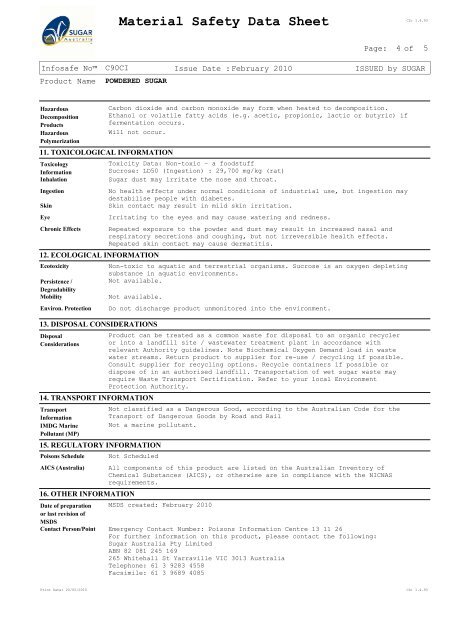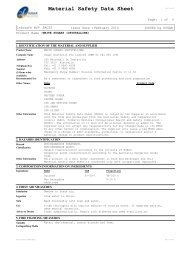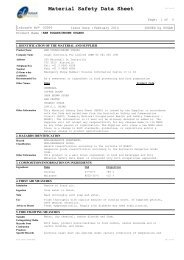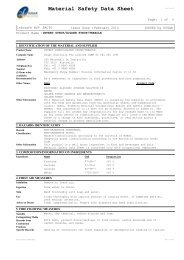Material Safety Data Sheet - Sugar Australia
Material Safety Data Sheet - Sugar Australia
Material Safety Data Sheet - Sugar Australia
You also want an ePaper? Increase the reach of your titles
YUMPU automatically turns print PDFs into web optimized ePapers that Google loves.
<strong>Material</strong> <strong>Safety</strong> <strong>Data</strong> <strong>Sheet</strong><br />
Page: 4<br />
CS: 1.4.93<br />
Infosafe No C90CI Issue Date : February 2010 ISSUED by SUGAR<br />
Product Name : POWDERED SUGAR<br />
Hazardous<br />
Decomposition<br />
Products<br />
Hazardous<br />
Polymerization<br />
Carbon dioxide and carbon monoxide may form when heated to decomposition.<br />
Ethanol or volatile fatty acids (e.g. acetic, propionic, lactic or butyric) if<br />
fermentation occurs.<br />
Will not occur.<br />
11. TOXICOLOGICAL INFORMATION<br />
Toxicology<br />
Toxicity <strong>Data</strong>: Non-toxic – a foodstuff<br />
Information<br />
Sucrose: LD50 (Ingestion) : 29,700 mg/kg (rat)<br />
Inhalation <strong>Sugar</strong> dust may irritate the nose and throat.<br />
Ingestion No health effects under normal conditions of industrial use, but ingestion may<br />
destabilise people with diabetes.<br />
Skin Skin contact may result in mild skin irritation.<br />
Eye Irritating to the eyes and may cause watering and redness.<br />
Chronic Effects Repeated exposure to the powder and dust may result in increased nasal and<br />
respiratory secretions and coughing, but not irreversible health effects.<br />
Repeated skin contact may cause dermatitis.<br />
12. ECOLOGICAL INFORMATION<br />
Ecotoxicity Non-toxic to aquatic and terrestrial organisms. Sucrose is an oxygen depleting<br />
substance in aquatic environments.<br />
Persistence /<br />
Not available.<br />
Degradability<br />
Mobility Not available.<br />
Environ. Protection Do not discharge product unmonitored into the environment.<br />
13. DISPOSAL CONSIDERATIONS<br />
Disposal<br />
Considerations<br />
14. TRANSPORT INFORMATION<br />
Transport<br />
Information<br />
IMDG Marine<br />
Pollutant (MP)<br />
15. REGULATORY INFORMATION<br />
Poisons Schedule Not Scheduled<br />
Product can be treated as a common waste for disposal to an organic recycler<br />
or into a landfill site / wastewater treatment plant in accordance with<br />
relevant Authority guidelines. Note Biochemical Oxygen Demand load in waste<br />
water streams. Return product to supplier for re-use / recycling if possible.<br />
Consult supplier for recycling options. Recycle containers if possible or<br />
dispose of in an authorised landfill. Transportation of wet sugar waste may<br />
require Waste Transport Certification. Refer to your local Environment<br />
Protection Authority.<br />
Not classified as a Dangerous Good, according to the <strong>Australia</strong>n Code for the<br />
Transport of Dangerous Goods by Road and Rail<br />
Not a marine pollutant.<br />
AICS (<strong>Australia</strong>) All components of this product are listed on the <strong>Australia</strong>n Inventory of<br />
Chemical Substances (AICS), or otherwise are in compliance with the NICNAS<br />
requirements.<br />
16. OTHER INFORMATION<br />
Date of preparation MSDS created: February 2010<br />
or last revision of<br />
MSDS<br />
Contact Person/Point Emergency Contact Number: Poisons Information Centre 13 11 26<br />
For further information on this product, please contact the following:<br />
<strong>Sugar</strong> <strong>Australia</strong> Pty Limited<br />
ABN 82 081 245 169<br />
265 Whitehall St Yarraville VIC 3013 <strong>Australia</strong><br />
Telephone: 61 3 9283 4558<br />
Facsimile: 61 3 9689 4085<br />
Print Date: 20/05/2010 CS: 1.4.93<br />
of<br />
5





